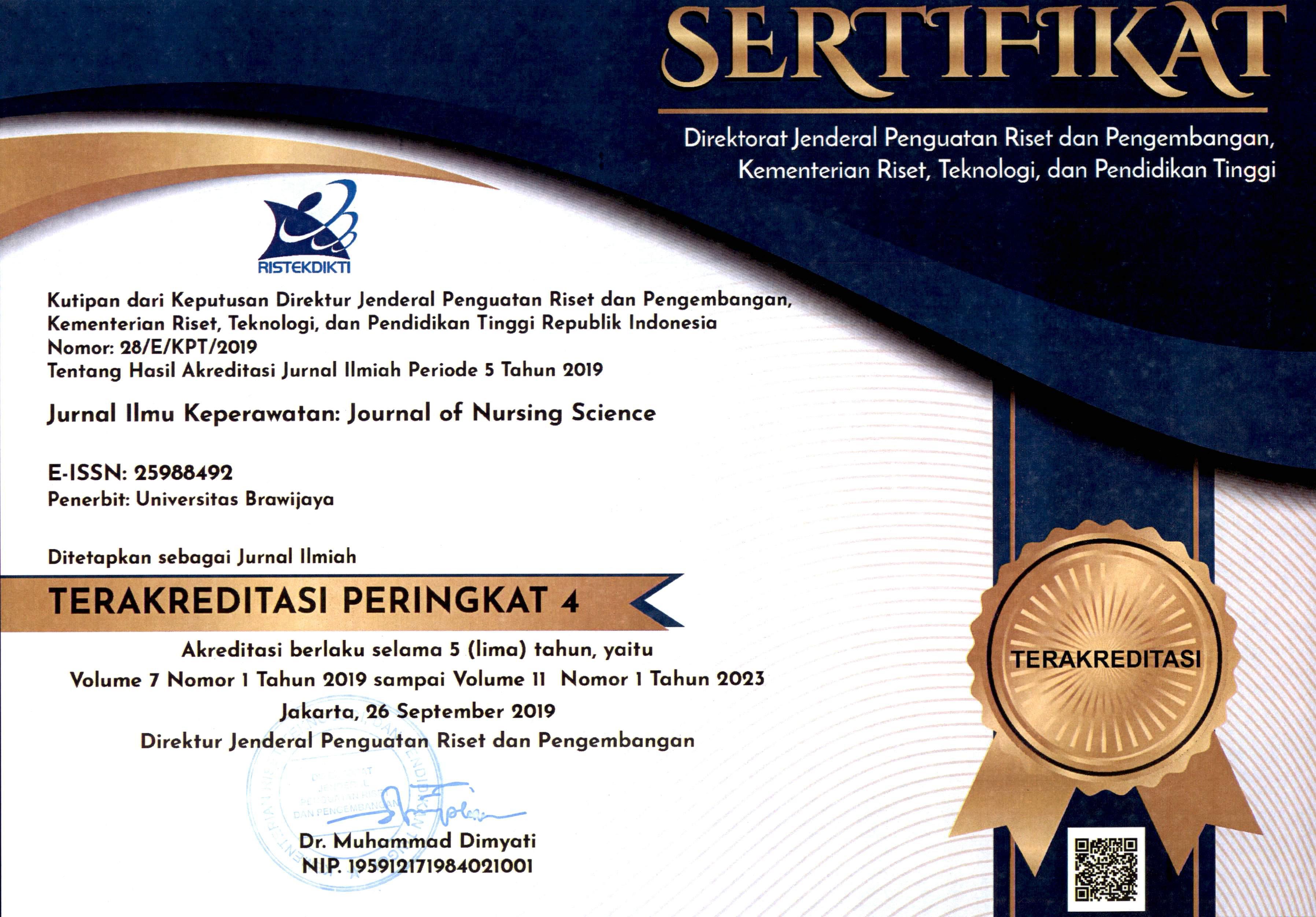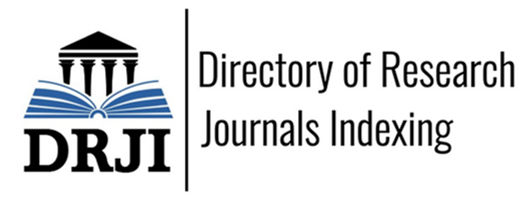THE EXPERIENCE OF INDONESIAN NURSES HANDLING EMERGENCY CONDITION IN OVERSEAS ARMED CONFLICT
DOI:
https://doi.org/10.21776/ub.jik.2019.007.01.1Keywords:
experience, nurse, victim of armed conflict, overseasAbstract
References
- Agazio, J. (2010). Army nursing practice challenges in humanitarian and wartime missions. International Journal Nursing Practice. 16, 166-175.
- Alligood, M. R. & Tomey, A. M. (2006). Nursing Theorists and Their Work (6th ed). Missouri : Mosby
- Baron, Robert.A & Byrne, Donn. (2008). Psikologi sosial jilid 2. Jakarta : Erlangga
- Clarke, V. and Braun, V. (2013). Successful qualitative research: A practical guide for beginners. London: Sage.
- Coupland, Robin. (2012). Health care in danger. the responsibilities of health-care personnel working in armed conflicts and other emergencies. Geneva : ICRC.
- Crigger, Nancy J., & Holcomb, Lygia. (2007). Practical strategies for providing culturally sensitive, ethical care in developing nations. Journal of Transcultural Nursing, 18(1), 69-76.
- Gaessler, B. And Schacter, D.L. (2013). Episodic simulation and episodic memory can increase intentions to help others. Center for brain science and departement of psycology, Hardvard University, Cambridge.
- Gebbie, Kristine M & Qureshi, Kristine A. (2006). A Historical Challenge: Nurses and Emergencies. OJIN: The Online Journal of Issues in Nursing. 11 (3), 1-14
- Gholamzadeh, S., Sharif, F., Rad, F.D. (2011). Sources of occupational stress and coping strategies among nurses who are working in admission and emergency departement in hospitals affiliated to shiraz university of medical sciences, Iran J Nurs Midwifery 16 (6) : 42-47
- Hajbaghery, MA., Khamechian, M., Alavi, NM. (2012). Nurses’perception of occupational stress and its uinfluencing factors : A qualitative study. Iranian journal of nursing and midwefery research 17 (5) : 352-359.
- Hammad, K.S., Arbon, P., Gebbie, K.M., Hutton, A. (2012). Nursing in the emergency departement (ED) during a disaster. A review of the curent literature. Australian emergency nursing journal. 15, 235-244.
- Hassmiller, S. B., & Stanley, S. A. R. (2012). Public health nursing and the disaster management cycle. Public Health Nursing. Missouri, MO: Mosby, 507-531.
- Human Rights Watch. (2015). Attacks On Health Global Report. http/:www.safeguardinghealth.org. Diakses tanggal 08 April 2016.
- Hunt, M. R. (2008). Ethics beyond borders: How health professionals experience ethics in humanitarian assistance and development work. Developing World Bioethics, 8(2), 59-69.
- International Council Nurse (ICN).(2009). ICN Framework of Disaster Nursing Competencies. Geneva : WHO Western Pacific Region.
- Lal, Shane. (2011). The experience of humanitarian nursing in developing countries . Dissertation.The degree of Master of Health Scienc. Auckland University of Technology. https://aut.researchgateway.ac.nz/.../browse?...aut. Diakses tanggal 01 Februari 2016.
- Ludigdo, U. (2012). Nilai-nilai luhur pancasila dalam mencegah terjadinya kecurangan. Naskah pidato pengukuhan guru besar pada fakultas ekonomi dan bisnis Universitas brawijayaa. 24 April 2012. www.accounting .feb.ub.ac.id
- Maulana, Antoni Eka Fajar. (2014). Studi fenomenologi : Pengalaman perawat puskesmas Belanting pada fase respon bencana banjir Sambelia di Nusa Tenggara Barat. Tesis. Malang : Universitas Brawijaya
- Medical Emergency Rescue Comitte (MER-C) (2015). Profil Medical Emergency Comitte. Jakarta : MER-C
- Peterson, Cheryl A. (2006). Be Safe, Be Prepared: Emergency System for Advance Registration of Volunteer Health Professionals in Disaster Response. Online J Issues Nurs, 11(3)
- Republika (2009). Yayasan Kristen kirim bantuan ke Gaza. www.republika .co.id. Diakses tanggal 15 Desember 2015.
- Roberts, David Lloyd. (2005). Staying alive, safety and security guidelines for humanitarian volunteers in conflict areas. Geneva, Switzerland : ICRC
- Safrilsyah, Jusoff, Kamaruzaman & Fadhil, Rahmat. (2009). Prosocial behavior motivation of acheness volunteers in helping tsunami disaster victims. Canadian Social Science. 5(3). 50-55.
- Scannell-Desch, E. A. (2005). Lessons learned and advice from Vietnam war nurses: a qualitative study. Journal of Advanced Nursing, 49(6), 600-607.
- Scheuren, J.M. , Hayes, J., RobinS, J.A. (2008). Annual disaster statitical review : The numberS and trends 2007. Available from centre for research on the epidemiology of Disasters http://www.emdat. be/documents/Publications/Annual%20Disaster%20StaticaL%Review%202007. Diakses tanggal 14 Juli 2016.
- Seaward, B.L. (2006). Managing stresss, principles, and strategis for health and well being. Jones and Barlett Publishers. Canada.
- Silvia (2009). Looking past pleasure : Anger, confusion, disgust, pride, surprise and other unusual aesthetic emotions. Psycology of aesthetics, creativity, and the arts. 3 (1). 48-51
- Ulmer, Deborah (2008) The Experience of Volunteering for Hurricane Katrina Relief / Theoretical Explanations for Nurses’ Involvement as Volunteers in Global Disasters. Dissertation. Virginia Commonwealth University. http://scholarscompass.vcu.edu/etd. Diakses tanggal 08 februari 2016.
- Wynd, Christine A. (2006). A Proposed Model for Military Disaster Nursing. The Online Journal of Issues in Nursing. 11 (3)
- United Nations Office for the Coordination of Humanitarian Affairs. (2014). Humanitarian Civil-Military Coordination A Guide for the Military. Geneva : UNOCHA
- United Nations Office for the Coordination of Humanitarian Affairs. (2015). World humanitarian data and trends 2015. New York and Geneva: UNOCHA
Downloads
Published
How to Cite
License
Authors published in this journal agree to the following terms:
1. The copyright of the received article shall be assigned to the journal as the publisher of the journal. The intended copyright includes the right to publish the article in various forms (including reprints). The journal maintains the publishing rights to the published articles.
2. Authors may enter into separate additional contractual agreements for the non-exclusive distribution of the published journal version of the work (for example, posting it to an institutional repository or publishing it in a book), with acknowledgment of their initial publication in this journal.
3. Authors are permitted and encouraged to post their work online (e.g. in an Institutional Repository or on their website) before and during the submission process, as this can result in a productive exchange, as well as earlier and larger citations of the published work.
4. Articles and all related material published are distributed under Creative Commons Attribution-NonCommercial 4.0 International License or CC BY-NC 4.0 license.
JNSU is licensed under a Creative Commons Attribution-NonCommercial 4.0 International License or CC BY-NC 4.0 license.
Most read articles by the same author(s)
- Bintari Ratih Kusumaningrum, Indah Winarni, Setyoadi Setyoadi, Kumboyono Kumboyono, Retty Ratnawati, PENGALAMAN PERAWAT UNIT GAWAT DARURAT (UGD) PUSKESMAS DALAM MERAWAT KORBAN KECELAKAAN LALU LINTAS , Journal of Nursing Science Update (JNSU): Vol. 1 No. 2 (2013)
- Maria Imaculata Ose, Retty Ratnawati, Retno Lestari, STUDI FENOMENOLOGI PENGALAMAN PERAWAT INSTALASI GAWAT DARURAT (IGD) DALAM MERAWAT PASIEN TERLANTAR PADA FASE END OF LIFE DI RSUD Dr. SAIFUL ANWAR MALANG , Journal of Nursing Science Update (JNSU): Vol. 4 No. 2 (2016)
- Ika Setyo Rini, Dini Widya Ayuningtyas, Retty Ratnawati, FAKTOR-FAKTOR YANG BERHUBUNGAN DENGAN PERSEPSI GEJALA NYERI DADA KARDIAKISKEMIK PADA PASIEN INFARK MIOKARD AKUT DI RSUD dr. SAIFUL ANWAR MALANG , Journal of Nursing Science Update (JNSU): Vol. 5 No. 1 (2017)
- Iva Milia Hani Rahmawati, Retty Ratnawati, Septi Dewi Rachmawati, PENGALAMAN PERAWAT DALAM MEMBERIKAN LAYANAN KEPERAWATAN JIWA PADA PECANDU NAPZA DI PUSAT REHABILITASI BADAN NARKOTIKA NASIONAL KARESIDENAN KEDIRI , Journal of Nursing Science Update (JNSU): Vol. 4 No. 2 (2016)
- Yati Nur Azizah, Retty Ratnawati, Setyoadi Setyoadi, PENGALAMAN PERAWAT DALAM MELAKUKAN PENILAIAN CEPAT KESEHATAN KEJADIAN BENCANA PADA TANGGAP DARURAT BENCANA ERUPSI GUNUNG KELUD TAHUN 2014 DI KABUPATEN MALANG (STUDI FENOMENOLOGI) , Journal of Nursing Science Update (JNSU): Vol. 3 No. 2 (2015)
- Fransiska Erna Damayanti, Retty Ratnawati, Fransiska Imavike Fevriasanty, PENGALAMAN ISTRI TENTARA (TNI-AD) YANG TINGGAL DI BATALYON SAAT SUAMI BERTUGAS DI DAERAH RAWAN KONFLIK , Journal of Nursing Science Update (JNSU): Vol. 4 No. 2 (2016)
- Sutono Sutono, Retty Ratnawati, Tony Suharsono, PERBEDAAN NILAI KOMPRESI DADA DAN VENTILASI PADA PELATIHAN RESUSITASI JANTUNG PARU MAHASISWA S1 KEPERAWATAN DENGAN UMPAN BALIK INSTRUKTUR, AUDIOVISUAL DAN KOMBINASI DI YOGYAKARTA , Journal of Nursing Science Update (JNSU): Vol. 3 No. 2 (2015)
- Merry Januar Firstiana, Retty Ratnawati, Retno Lestari, FENOMENOLOGI : PENGALAMAN CARING PERAWAT PADA PASIEN TRAUMA DENGAN KONDISI KRITIS (P1) DI IGD RSUD TARAKAN-KALIMANTAN UTARA , Journal of Nursing Science Update (JNSU): Vol. 5 No. 1 (2017)
- Ulfa Fauziyah Hayati, Fransiska Imavike Fevriasanty, Muladefi Choiriyah, THE EFFECT OF HEALTH EDUCATION WITH AUDIO-VISUAL MEDIA TOWARD EXTERNAL GENITAL HYGIENE BEHAVIORS TO PREGNANT WOMEN IN PRIMARY HEALTH CARE OF MALANG WORKING AREA , Journal of Nursing Science Update (JNSU): Vol. 6 No. 1 (2018)
- Rita Rinjani Mekka, Retty Ratnawati, Septi Dewi Rachmawati, STUDI FENOMENOLOGI : PENGALAMAN PERAWAT TERKAIT KETIDAKBERHASILAN RESUSITASI PADA NEONATAL DENGAN ASFIKSIA DI RUANG NEONATUS RSUD DR. R. SOEDJONO SELONG LOMBOK TIMUR , Journal of Nursing Science Update (JNSU): Vol. 4 No. 2 (2016)





























